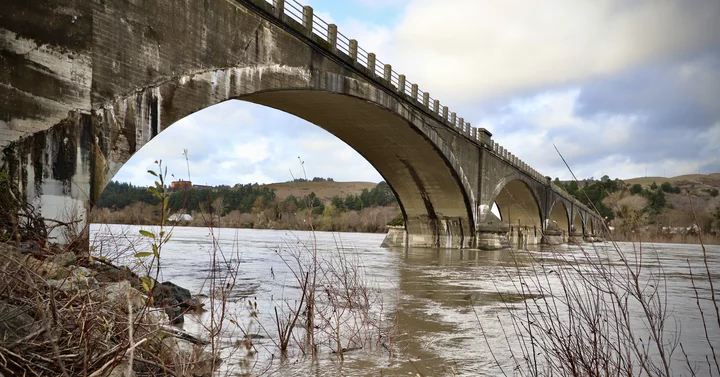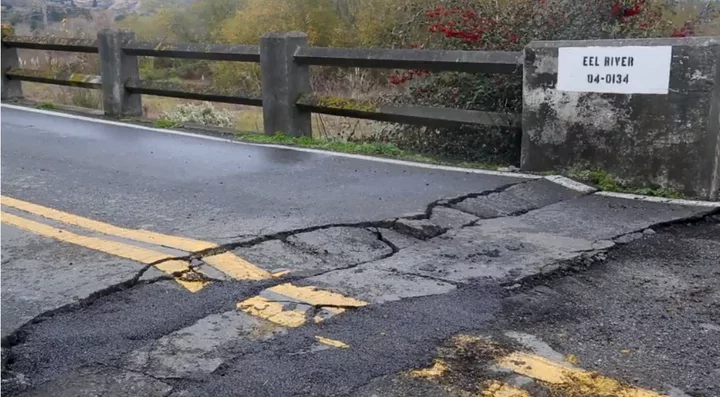Fernbridge, dubbed the “Queen of Bridges” upon its construction in 1911, suffered damage during December’s 6.4 magnitude earthquake.
# # #
At nearly 112 years old, Fernbridge is showing its age. After suffering structural damage during the 6.4 magnitude earthquake and numerous aftershocks that struck the region in December and January, the bridge’s long-term future may be in jeopardy.
“As Caltrans continues to prioritize the safety and sustainability of its structures, multiple long-term solutions are being considered for Fernbridge including further rehabilitation or the construction of a new bridge,” Caltrans Public Information Officer Myles Cochrane said via email.
A “final course of action” won’t be determined without further analysis and stakeholder engagement, he told the Outpost, adding, “If and when a long-term solution is initiated, Caltrans will reach out and provide many opportunities for public engagement.”
More than two months after the big quake hit on December 20, Caltrans is still limiting traffic across the bridge to one direction at a time, with vehicles lining up on either side to await their turn to cross.
Buckled asphalt at the eastern end of Fernbridge following the December 20 earthquake. | Image via Caltrans
Since the quake, crews have made repairs to the bridge’s asphalt and concrete columns, and they continue to patch cracks, aka “spalls,” under the bridge, Cochrane said.
“There have to be safety improvements made, [but] I think it’s gotten to be too big of a cost to do,” First District Supervisor Rex Bohn said.
Two-way traffic could resume on the bridge in late spring or early summer, barring unforeseen circumstances, Cochrane added, and he assured travelers that so long as the bridge remains open, it has been inspected and deemed safe by experts.
At 1,320 feet long, Fernbridge was declared the world’s largest and longest concrete bridge when it opened in November of 1911. Reinforced concrete was used during construction of its arched design because studies conducted after the 1906 San Francisco earthquake showed that the material was good at withstanding the earth’s rumbles.
Alas, more than a century spent atop one of the most seismically active regions in the world takes its toll.
“It remains a structural work of art to this day,” says the narrator of a historical video about the bridge released last year. “Fernbridge has endured the raging waters of devastating floods, pounded by the heaviest drift logs of any river anywhere.”
Fernbridge remains the longest poured-concrete bridge in operation in the world, according to the video. In 1976 it was designated a historic civil engineering landmark.
In 1987 Caltrans recommended studying the possibility of replacing the bridge with a more modern structure, but local residents rallied to protect the structure, with Ferndale’s then-mayor, Richard Farrington, comparing its artistic value to that of the Statue of Liberty. In April that year Fernbridge was added to the National Register of Historic Places.
Cochrane said Caltrans “understands the historic value of Fernbridge as well as the vital role the bridge plays in the Eel River Valley.”
So if a new bridge gets built, will Fernbridge be demolished?
“That’s a great question,” Cochrane replied, “because it allows us to highlight once again that there would be many opportunities for public engagement if and when a long-term solution is initiated.”
He continued, “If such an effort is initiated it would require a considerable amount of further study, discussion and public engagement. In similar instances bridges have been kept for pedestrian use or they’ve been relinquished, which are options that have seen consideration as well. In terms of a definitive answer to that question, we’re just not there yet.”
Bohn said he’s heard that officials are “pretty adamant” about keeping Fernbridge in place, at least as a walking bridge, in which case the new bridge would be built far enough out of the way to retain the aesthetics of Fernbridge’s distinctive design.
“That’s what I’ve been hearing,” Bohn said, adding, “Safety is going to be job one.”
A town hall meeting to discuss the bridge’s future will be held at Ferndale City Hall, 834 Main Street, at 6 p.m. on Monday, March 6. Bohn will be present along with Ferndale Mayor Randy Cady. Caltrans will offer a presentation updating the community about where things stand and what’s in store.


CLICK TO MANAGE